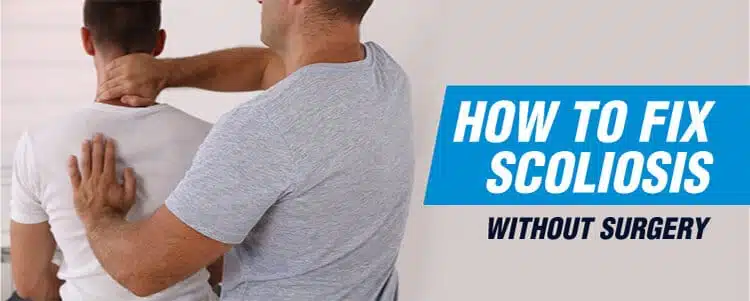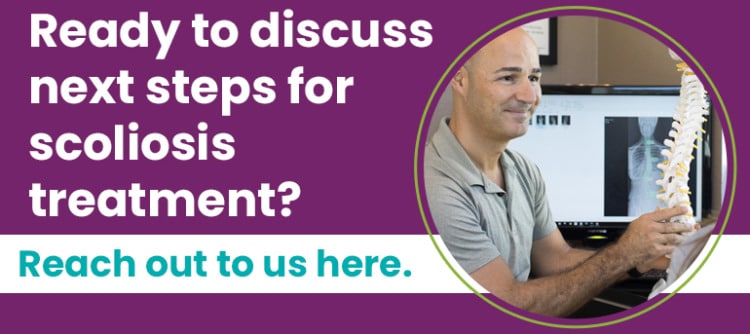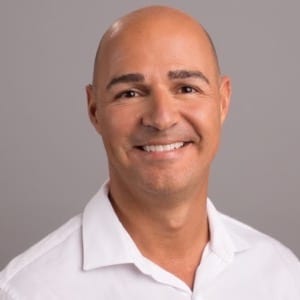Before approaching the question of how to fix scoliosis naturally without surgery, I have to be clear that there’s no known way to ‘fix’ scoliosis; it’s an incurable condition with no known single cause. That being said, my functional scoliosis-specific chiropractic approach offers impressive results and includes a number of non-surgical strategies for managing the condition.
What is Scoliosis?
Scoliosis is a complex medical condition characterized by an abnormal curvature of the spine, which can occur in various forms and for different reasons. The spine may curve to the side in an “S” or “C” shape, and this curvature can be mild or severe. The cause of scoliosis remains unknown in many cases, particularly in adolescent idiopathic scoliosis, which is the most common type.
However, scoliosis can also be attributed to specific factors such as genetics, neuromuscular disorders, or degenerative conditions. It affects approximately 2% to 3% of adolescents, making it a relatively common spinal deformity.
Signs and Symptoms of Scoliosis
Scoliosis symptoms can vary widely, and some individuals may be asymptomatic, making it challenging to detect early. Common signs include uneven shoulders or hips, a prominent ribcage on one side, and an overall sense of being off-center. In more severe cases, scoliosis may cause back pain, muscle spasms, or difficulty breathing due to the impact on lung function.
It is essential to recognize the symptoms of scoliosis to ensure early diagnosis and treatment. If you or a loved one notice any of these signs, it is crucial to consult a healthcare professional for a thorough evaluation.
Diagnosing Scoliosis
Scoliosis often progresses gradually and may not be apparent until it has advanced significantly. Routine medical checkups frequently reveal the condition, especially in children and adolescents. To confirm a scoliosis diagnosis, healthcare providers typically use imaging studies such as X-rays, CT scans, or MRIs to visualize the spinal curvature. These images help determine the severity and exact location of the spinal curve.
A thorough physical examination and detailed medical history are also essential components of diagnosing scoliosis. Early detection through these methods can lead to more effective management and better outcomes for scoliosis patients.
Traditional Treatment and Spinal-Fusion Surgery
The traditional scoliosis treatments that most often end in spinal-fusion surgery involves a lot of watching and waiting. Most often, a scoliosis diagnosis will be followed with the advice of, “There is a curvature, but let’s monitor it to see how it progresses.” While that doesn’t sound like bad advice, there are some dangers to be aware of.
While some curvatures don’t progress or progress very slowly, in the majority of cases, progression is an issue, and no abnormal spinal curvature is simply going to correct itself. Often the waiting time that passes between X-rays can end up being harmful, especially in cases of adolescent scoliosis where growth spurts are still occurring. Rapid growth equals rapid curvature progression, and that is why I don’t subscribe to the traditional watching-and-waiting approach.
If an adolescent is first diagnosed with a 10-to-15 degree curve, their scoliosis lands on the ‘mild’ range. However, if they then wait three-to-six months for the next X-ray and, in that time, experience a huge growth spurt that progresses their curvature significantly, they are only closer to that 25-degree surgical curve.
While spinal-fusion surgery does have its place in extreme cases, if you are asking how to fix the condition without surgery, you’re likely aware there are some costs and risks involved.
The Process of Spinal-Fusion Surgery
Spinal-fusion surgery involves fixing a scoliosis curve by realigning and fusing the curved vertebrae together with the end goal of them healing into a single bone. Rods, plates, wires or screws can be used to hold the bones together while the fusion heals.
Every case is different, and the degree of flexibility a patient is left with after spinal-fusion surgery depends on a number of factors including the degree of flexibility their scoliosis had given them prior to surgery, age, and fitness level.
One of the main issues I have with spinal-fusion surgery is what kind of life the patient is left with post-surgery. While the surgery is often successful in terms of giving the patient a straighter spine, the spine is held in alignment, which can have a high cost in terms of flexibility and functionality.
Depending on the severity of your scoliosis and surgery, recovery time varies. For some, it can take several months for the fusion to heal. With spinal fusion, a section of the spine is immobilized, and that can cause additional pressure and stress on the fused portion, worsening the condition over time and necessitating additional surgeries in the future.
Additional risk factors associated with spinal-fusion surgery:
- Possibility of infection
- Poor wound healing
- Bleeding
- Blood clots
- Blood vessels or nerves in and around the spine can be injured
- With bone grafts, pain at the site where bone is removed
- Limited flexibility after the surgery
- Long recovery time
- Monetary expense of surgery
- Possibility of additional surgeries in the future
‘Fixing’ Scoliosis: Effective Scoliosis Treatment
In terms of ‘fixing’ scoliosis, I wish I could say I have a clear-cut answer, but scoliosis is incurable. People with scoliosis will be living with the condition throughout their lives, but that doesn’t have to be seen as some kind of sentence. The more relevant issue then becomes how to manage the condition, prevent its progression, and support patients and loved ones so they can live their best lives enjoying the physical activities they love the most. Non-surgical interventions, such as corrective exercises, Scolibrace, and the Schroth Method, can contribute to scoliosis improvement by enhancing posture, muscle balance, and overall quality of life.
Depending on the treatment approach you choose for yourself or your loved one, there are different ways to approach living with the condition and managing its progression. I encourage patients and their caregivers to take a proactive approach to manage their condition, and in my experience, starting treatment right away, rather than passively monitoring the curve’s progression, is the best course of action.
My Functional Approach
Here at the Scoliosis Reduction Center®, my team and I offer our patients access to multiple forms of treatment that are designed to treat the whole patient. We feel that there is more to managing scoliosis than simply straightening the spine. While we are working towards the ultimate goal of a curvature reduction, we also value quality of life and functionality throughout treatment and beyond.
If our treatment resulted in a straighter spine but came at the cost of flexibility and functionality to the point where an athlete couldn’t participate in the sport that gives their life meaning, we wouldn’t consider our approach a success. We consider a treatment plan successful when it provides a patient with relief, prevents progression, and results in a curvature reduction while still allowing the patient to participate in the activities they love.
At the Scoliosis Reduction Center®, we work closely with our patients and their caregivers to come up with a treatment plan that works best for each individual patient. If sports are a huge part of one patient’s life, we want our approach to allow that patient to maintain their physical fitness level and continue actively participating in their sport throughout treatment.
Our strategy is to strengthen the spine in a corrective position through a combination of scoliosis-specific chiropractic care, exercises and rehabilitation, specialized custom 3-D bracing, and the expertise of a physical therapist. A physical therapist can assess individual conditions and provide specific exercises, such as those from the Schroth Method, to improve posture and muscle imbalances, ultimately aiding in the prevention of further spinal curve progression; whereas spinal fusion holds the spine in a corrective position, but does so at the cost of function, flexibility, and range of motion.
Lifestyle and Scoliosis Management
There are many non-surgical ways to manage living with scoliosis, and I encourage my patients to take advantage of most of them. As I said before, there’s no known way to simply ‘fix’ scoliosis, but there are conditions that can be created within the body that better enable its ability to heal and minimize the negative aspects of the condition.
While lifestyle choices such as diet and exercise are important for anyone wanting to live their best lives, individuals with scoliosis, especially those with an abnormally curved spine, have even more reason to put some thought into their choices to better manage their condition.
Exercise
Many of my scoliosis patients, both young and old, come to me with the expectation of being told they can’t or shouldn’t exercise and that they’re likely to have to give up a lot of the physical activities they love. However, scoliosis exercises, including stretching and strengthening routines, are a natural treatment option that can alleviate discomfort and improve movement. It is important to seek professional guidance to ensure these exercises are safe and effective.
In extreme cases, you could be limited and unable to partake in certain sports that promote thoracic extension or favor the overuse of one side of the body, but in most cases, I encourage exercise and continuing with the physical activities that give my patient’s lives meaning. Exercise is known as nature’s antidepressant for a reason, and those benefits are essential to patients living their best lives with any condition.
Safe Exercises for People Living with Scoliosis
Exercises like swimming, walking and running are more than safe for people with scoliosis, and scoliosis-specific exercises such as stretching, rowing, planking, and the CLEAR Institute’s (Chiropractic Leadership, Educational, Advancement, and Research) list of back exercises have a lot of benefits. When used effectively, these exercises can increase strength, functionality, and provide relief.
Patients who approach me with an already-established healthy lifestyle do far better throughout their course of treatment. That is because they are healthier from the onset and are in better shape to tolerate the mental and physical demands of scoliosis-specific chiropractic exercise and rehabilitation while living with their condition.
A good attitude can go a long way, so my treatment plans include a scoliosis-specific exercise regimen that helps my patients maintain a positive physical fitness level and healthy attitude that promotes function and flexibility. These exercises are tailored to address different types of spinal curves, ensuring that each patient’s unique curvature and alignment issues are managed effectively.
Scoliosis-Friendly Diet and Nutrition
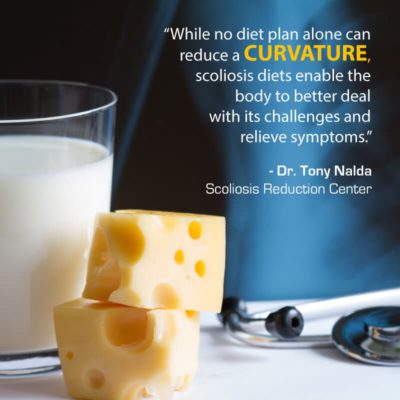
At first thought, it wouldn’t seem like diet would be an important part of treating scoliosis or living with the condition. However, the spine’s curve plays a significant role in understanding scoliosis, and diet can help manage spinal health. At the Scoliosis Reduction Center®, we work on treating the whole patient and diet is a part of that.
While no diet plan alone can reduce a curvature, scoliosis diets enable the body to better deal with its challenges and relieve symptoms.
Once I address the structural issues of a patient’s curvature, diet and nutrition also become important elements of my treatment plan.
Let’s explore the importance of a healthy diet and food that are Scoliosis Friendly foods and some foods to avoid.
Why diet and nutrition are extra important for people with scoliosis:
- Leaner patients, especially when they’re adolescents, respond better to exercise, rehabilitation, chiropractic therapy, and corrective bracing.
- Studies show a connection between neurotransmitters (chemical messengers in the body) and the development of scoliosis. A diet rich in amino acids encourages the body’s natural development of neurotransmitters, which can positively impact the condition.
- A diet including methylated B12 can help the body to produce neurotransmitters like dopamine and serotonin.
- Diet improves mood. Once patients see and feel the benefits of positive diet and nutrition changes, those affects transfer to other aspects of treatment they are then more likely to engage in a positive way.
- There’s a connection between lower bone density and scoliosis. A diet that encourages strong bones can improve overall bone health.
- A diet that counteracts inflammation also positively impacts bone health.
Now that we’ve discussed the general ways that food can impact scoliosis, let’s take a look at some specific food suggestions that people with scoliosis should embrace and avoid.
Scoliosis-Friendly Foods:
- Fresh fruits and vegetables – packed with nutrients and can help prevent inflammation
- Unprocessed meats – provide essential protein for healthy muscles
- Foods rich in calcium and vitamin D – promote overall bone health
- Water – keeps the body’s systems working and can help curb unhealthy snacking
Foods to Avoid:
- Fast food
- Processed foods
- Artificial sweeteners
- Soy milk
- Pasteurized milk
- MSG-heavy foods
- Salty foods
- Sugary foods
- Alcohol
- Coffee
- White flour
- Chocolate
The majority of the aforementioned foods are not conducive to a scoliosis-friendly diet because they contain high levels of preservatives, salt, sugar, and rob the bones of calcium. These kinds of foods also can lead to inflammation and obesity. They are also not amino acid-rich foods that help stimulate the body’s production of neurotransmitters that help systems within the body to communicate.
For a more comprehensive understanding of the role that diet and nutrition play in scoliosis, my book Scoliosis Hope has a large section devoted to exploring the place of diet, exercise, and lifestyle in managing the condition.
Non-Surgical Scoliosis Treatment Options
Not every scoliosis case requires surgical intervention. Many individuals can manage their condition through conservative methods. Non-surgical treatments include physical therapy, scoliosis-specific exercises, corrective bracing, and home rehabilitation programs. These treatments aim to improve spinal alignment, reduce pain, and enhance overall spinal health.
Additional Scoliosis Surgery Questions
How is Scoliosis Surgery Performed?
Scoliosis surgery, specifically spinal fusion, is aimed at halting the progression of the spinal curvature characteristic of scoliosis. During the procedure, surgeons fuse the most-tilted vertebrae at the curve’s apex to create a single, solid bone. This fusion is intended to eliminate movement in the affected area of the spine, thereby preventing further progression of the curve. The surgery involves attaching rods and screws to the spine to maintain its alignment until the fused vertebrae heal into a single bone.
While the primary goal of this invasive procedure is to stop the curvature from worsening, it is important to note that it does not guarantee a permanent solution to scoliosis progression and comes with significant risks, including infection, nerve damage, and potential long-term implications on spine flexibility and function.
Given the invasive nature and associated risks of spinal fusion, it’s critical for patients and their families to consider non-surgical treatment options as well. Non-surgical approaches, such as condition-specific chiropractic care, scoliosis-specific exercises, and corrective bracing, aim to manage scoliosis progression more conservatively. These treatments focus on reducing the spinal curvature, improving posture, and enhancing core strength to support the spine better.
By addressing scoliosis through a multifaceted approach that combines physical therapy, chiropractic adjustments, and customized exercise programs, patients can work towards stabilizing their condition with a lower risk of complications. Such conservative treatments offer an alternative for those seeking to avoid the potential downsides of surgery, aiming for correction and management of the condition while preserving spinal health and function.
Does Scoliosis Surgery Work?
Scoliosis surgery, specifically spinal fusion, is a significant decision for individuals with this condition, aiming to straighten the spine and halt the condition’s progression. However, the outcomes and side effects of such an invasive procedure bring to light several considerations regarding the spine’s health and functionality post-surgery. Spinal fusion entails fusing the spine’s most tilted vertebrae to prevent further curvature, which, while effective in halting progression, sacrifices the spine’s natural flexibility and range of motion.
This loss of movement is not just a temporary adjustment but a permanent change that affects the patient’s quality of life, potentially leading to stiffness, muscle pain, and a decreased ability to engage in activities they once enjoyed.
Moreover, the surgery carries inherent risks common to all surgical procedures, such as nerve damage, infection, and adverse reactions to the hardware used, which can introduce a range of short- and long-term complications. The permanence of these effects, alongside the possibility of needing additional surgeries due to hardware issues or unsuccessful fusion, underscores the importance of carefully considering non-surgical alternatives.
These alternatives, such as chiropractic adjustments, scoliosis-specific exercises, and corrective bracing, aim to manage and potentially reduce curvature without the need for invasive surgery. By addressing scoliosis proactively and with a focus on preserving the spine’s natural functions, patients may find a path to managing their condition that aligns more closely with their long-term health and lifestyle goals.
Do You Need Scoliosis Surgery?
When faced with the daunting prospect of scoliosis surgery, many patients and their families feel trapped between an invasive procedure and the progressive worsening of the condition. The narrative often presented to them emphasizes surgery as the sole path to relief, underpinned by a reactive healthcare approach prevalent in the United States. This perspective, while understandable given the complex nature of scoliosis and the healthcare system’s structure, overlooks the crucial aspect of patient-centered care.
Surgery, with its lengthy recovery time, potential for complications, and significant costs, not to mention the absence of guarantees regarding pain reduction, functional improvement, or cosmetic correction, represents a critical juncture in scoliosis management. It’s at this point that the Scoliosis Reduction Center® offers an alternative narrative—one that diverges from the conventional “wait-and-see” method that leads many down the path of surgical intervention.
The Scoliosis Reduction Center® champions a proactive, functional approach to scoliosis care, which stands in stark contrast to the traditional surgical route. This approach is grounded in a comprehensive treatment strategy that combines active and passive rehabilitation, exercise therapy, and chiropractic care. The objective is not merely to halt the progression of the curve but to enhance the spine’s structural integrity and functional capacity. The results speak volumes, with a significant majority of patients experiencing noticeable relief and improvement in just two weeks. This success rate challenges the prevailing narrative and demonstrates the potential for non-surgical interventions to effect meaningful change in patients’ lives.
This alternative approach transcends the conventional boundaries of scoliosis treatment by focusing on strengthening the spine, thereby averting the need for surgery and its associated downsides. By advocating for a treatment pathway that prioritizes the patient’s overall well-being and long-term health over the immediate benefits perceived from surgery, the Scoliosis Reduction Center® illustrates that scoliosis surgery is not the only option. Patients are empowered with knowledge and alternatives, ensuring that decisions made are in their best interest, reflecting a true patient-centered care ethos.
Is Spinal Fusion Surgery a Cure for Spinal Deformity?
It’s important to understand that spinal fusion surgery is not a cure for scoliosis. While the procedure can reduce or stabilize the curvature of the spine, it does not address the underlying causes of the condition. Furthermore, surgery can introduce new challenges and does not guarantee a return to a “normal” state of health. Scoliosis is a complex condition with no one-size-fits-all solution, and even after successful surgery, some patients may experience a worsening of their condition.
Therefore, surgery should be considered carefully and usually as a last resort, after exploring less invasive, alternative treatments that focus on improving quality of life and spinal health.
What Are the Long-Term Effects of Spinal Fusion Surgery on Mobility?
Spinal fusion surgery can significantly impact mobility, often resulting in a noticeable decrease. Studies have shown that mobility can decrease by an average of 25% following surgery, with these reductions persisting even 20 years later. The surgery involves the removal of spinal discs and the fusion of vertebrae, which restricts the spine’s natural flexibility. While some patients may retain levels of mobility close to their pre-surgery state, this is rare.
It’s crucial for patients to consider the permanent changes surgery imposes on the body’s mobility and weigh these against the potential benefits of alternative, non-invasive treatments that aim to preserve and enhance spinal function and overall mobility.
How Much Does Scoliosis Surgery Cost?
In addition to the invasive nature of the procedure, scoliosis back surgery cost can be high, and while there are a number of factors (surgeon fees, surgery location, recovery time spent in hospital, surgery length, condition severity, patient age, etc.) that can make the cost fluctuate, the average cost of spinal fusion in the United States is $126,000.
It’s also important to remember that there is a non-monetary cost of the procedure, and what patients are most disappointed with post-surgery is their loss in spinal flexibility and range of motion.
In addition, a fused spine is more vulnerable to injury, sometimes causing activity restrictions and making patients more hesitant to try new things or partake in once-loved physical activities.
Conclusion
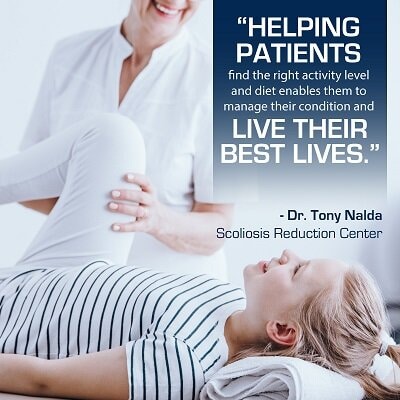
When it comes to designing a treatment plan that gives each and every patient the best possible chance of avoiding surgery, experiencing relief, preventing progression, and achieving a reduction, balance is a huge part of success. That’s why me and my team at the Scoliosis Reduction Center® work so closely with our patients and their caregivers in designing a treatment plan that strikes that perfect balance that is both manageable and sustainable. Helping our patients find the right activity level and diet to best assist them in managing their condition helps them live their best lives throughout treatment and beyond.
My scoliosis-specific exercise regimen will differ from patient to patient depending on a number of factors such as physical fitness at the time of diagnosis, degree of curvature, level of flexibility, and mindset. Diet and exercise can hugely impact overall health and wellness, and that’s why once the larger structural issues of the curvature are tackled, my full treatment plan then widens to include diet, exercise, and overall scoliosis-friendly lifestyle tips.
Although I wish I could say I have a solid ‘fix’ for scoliosis without surgery, I can offer my patients the next best thing: an alternative treatment plan that includes multiple ways to manage their condition naturally, prevent its progression, and achieve a reduction. When paired with my patient-centered functional approach, positive diet and exercise changes can help create conditions in the body that promote healing, strength, and positive management of the condition.
